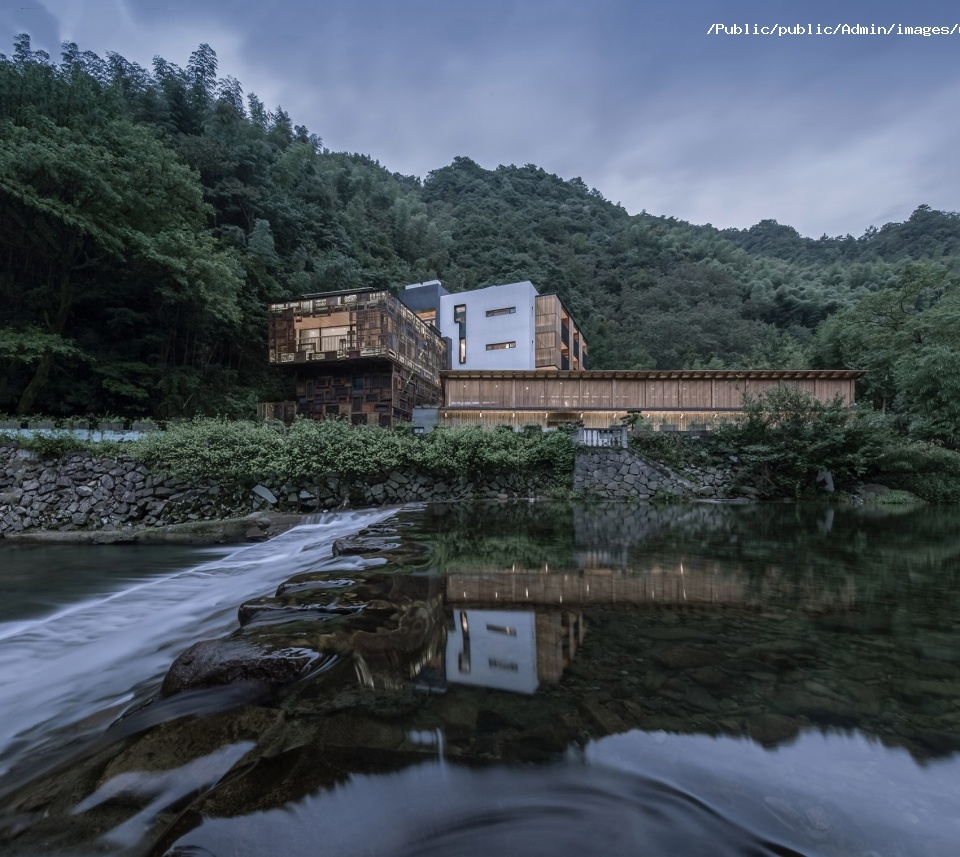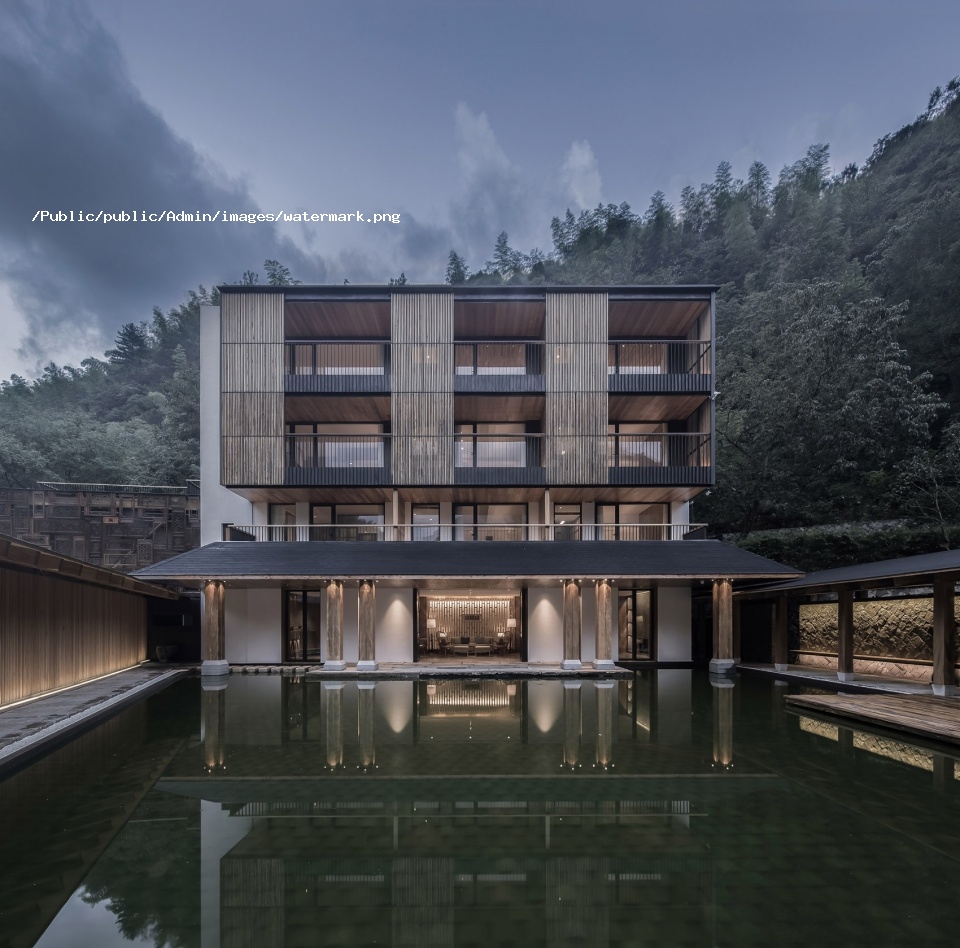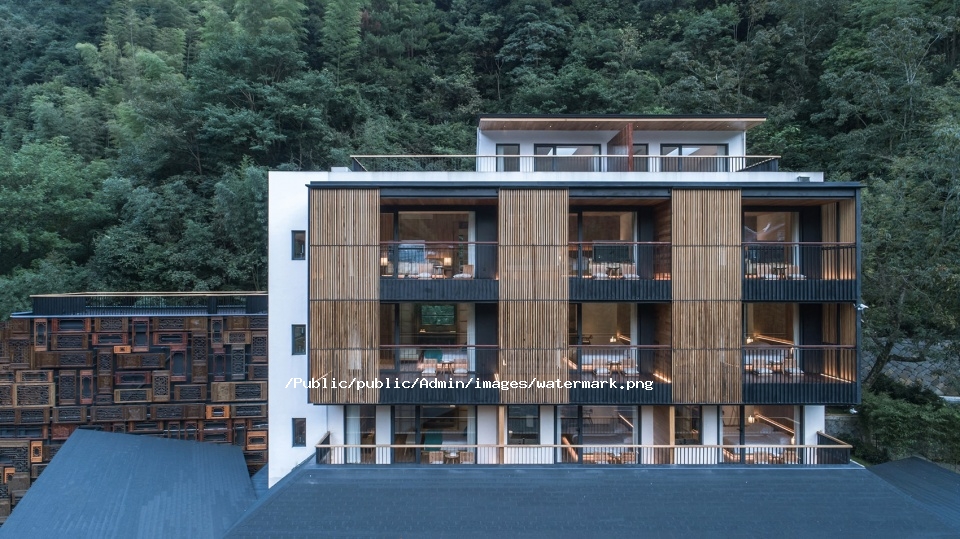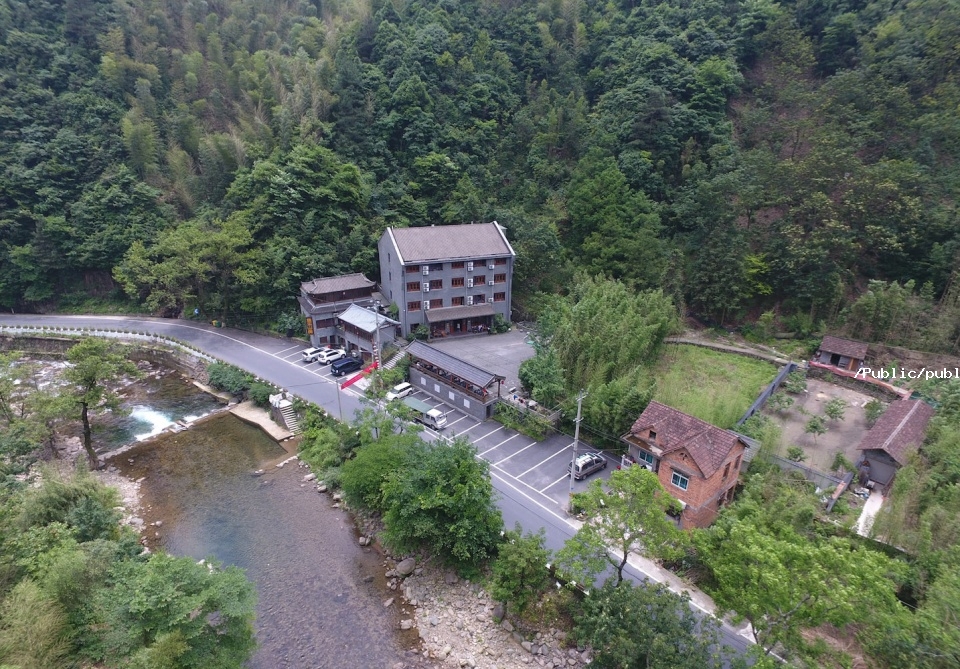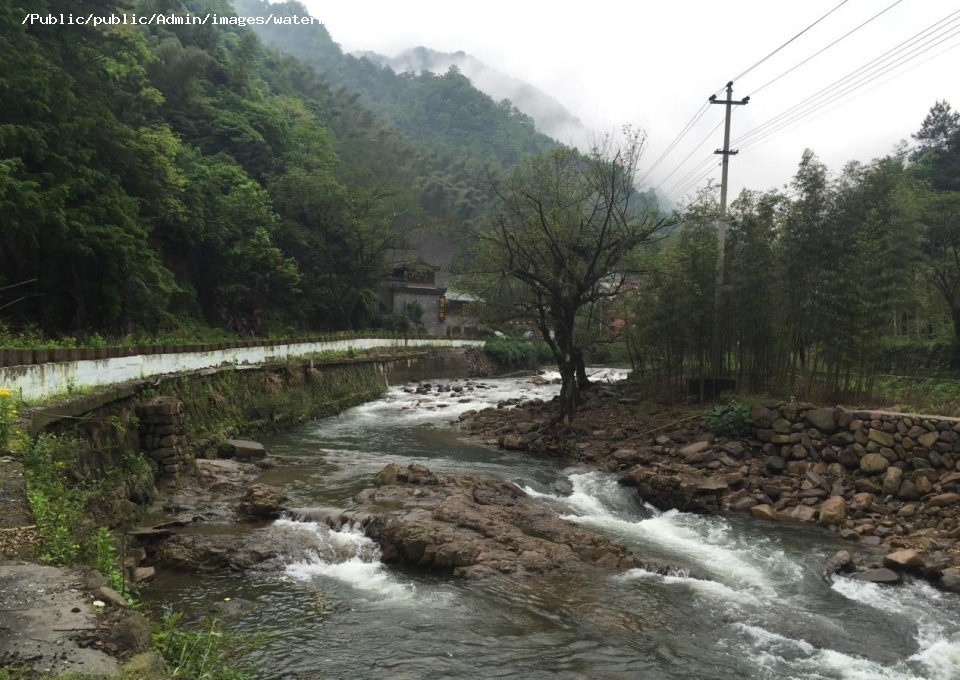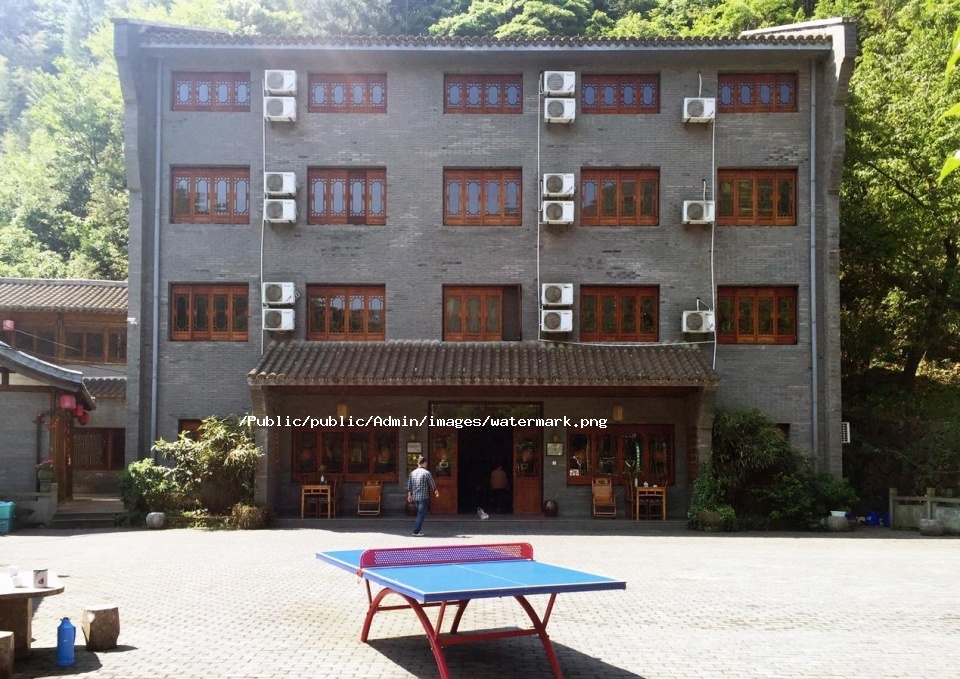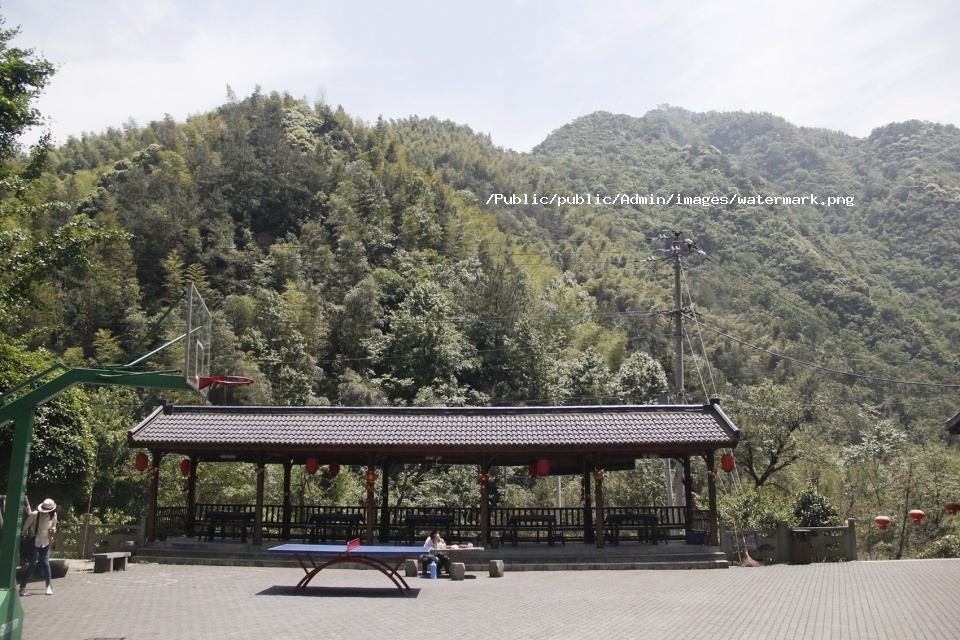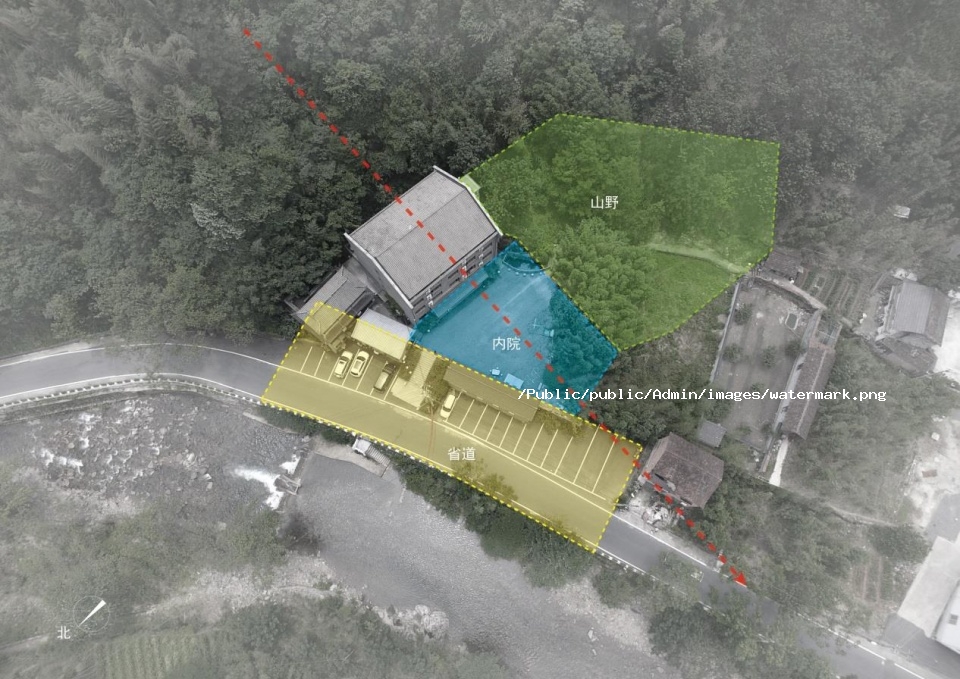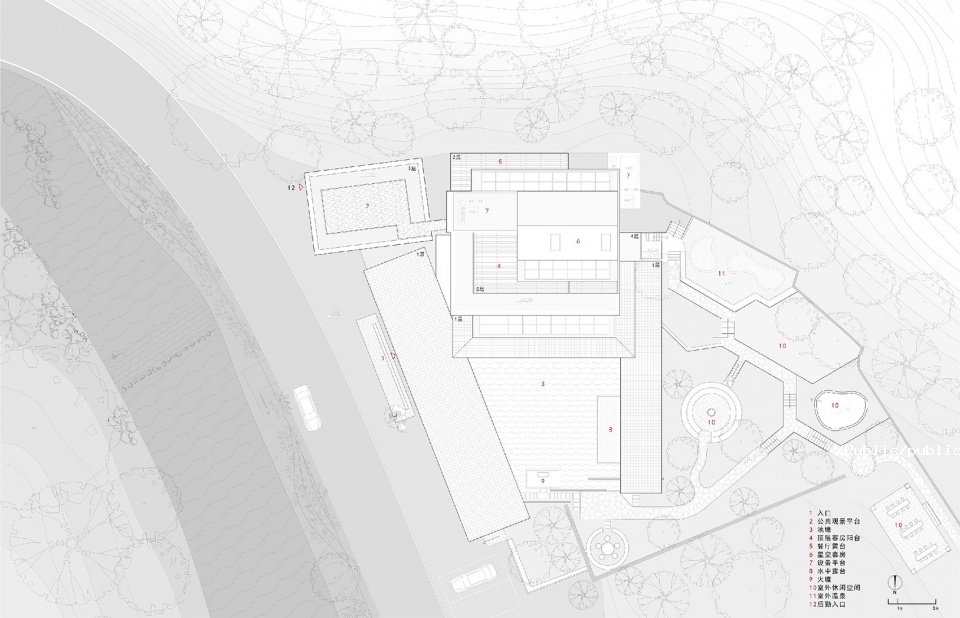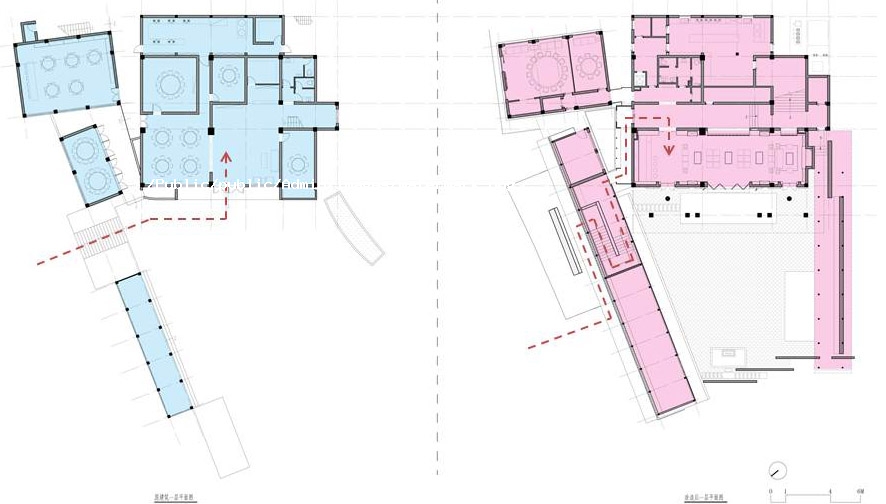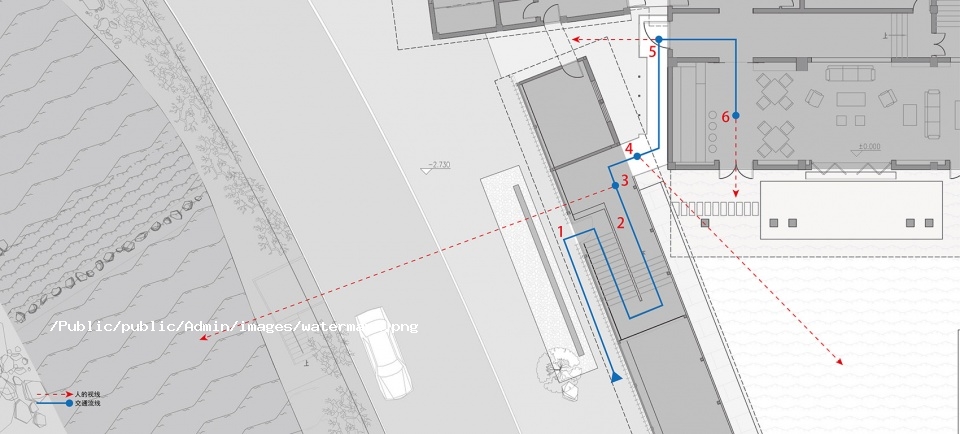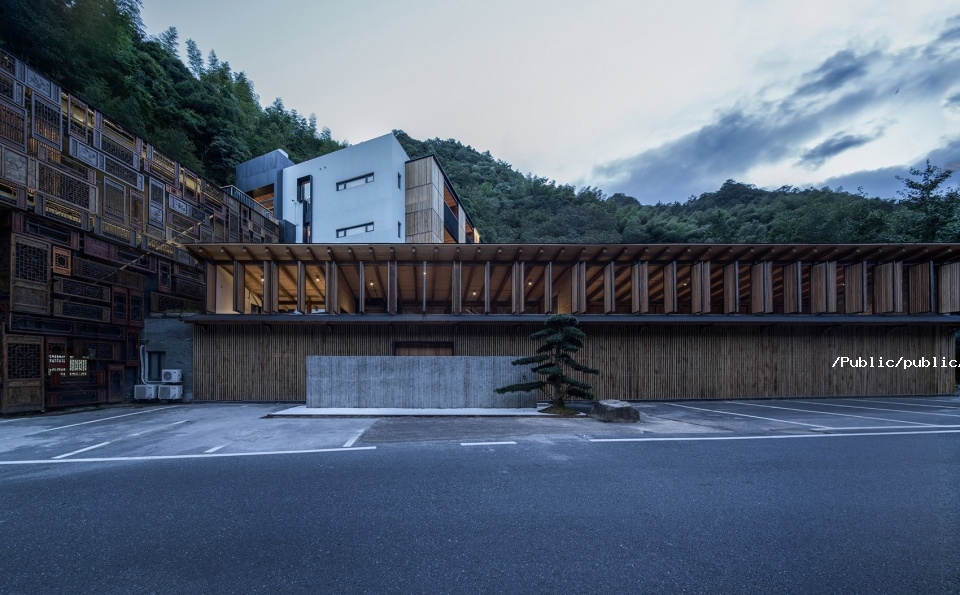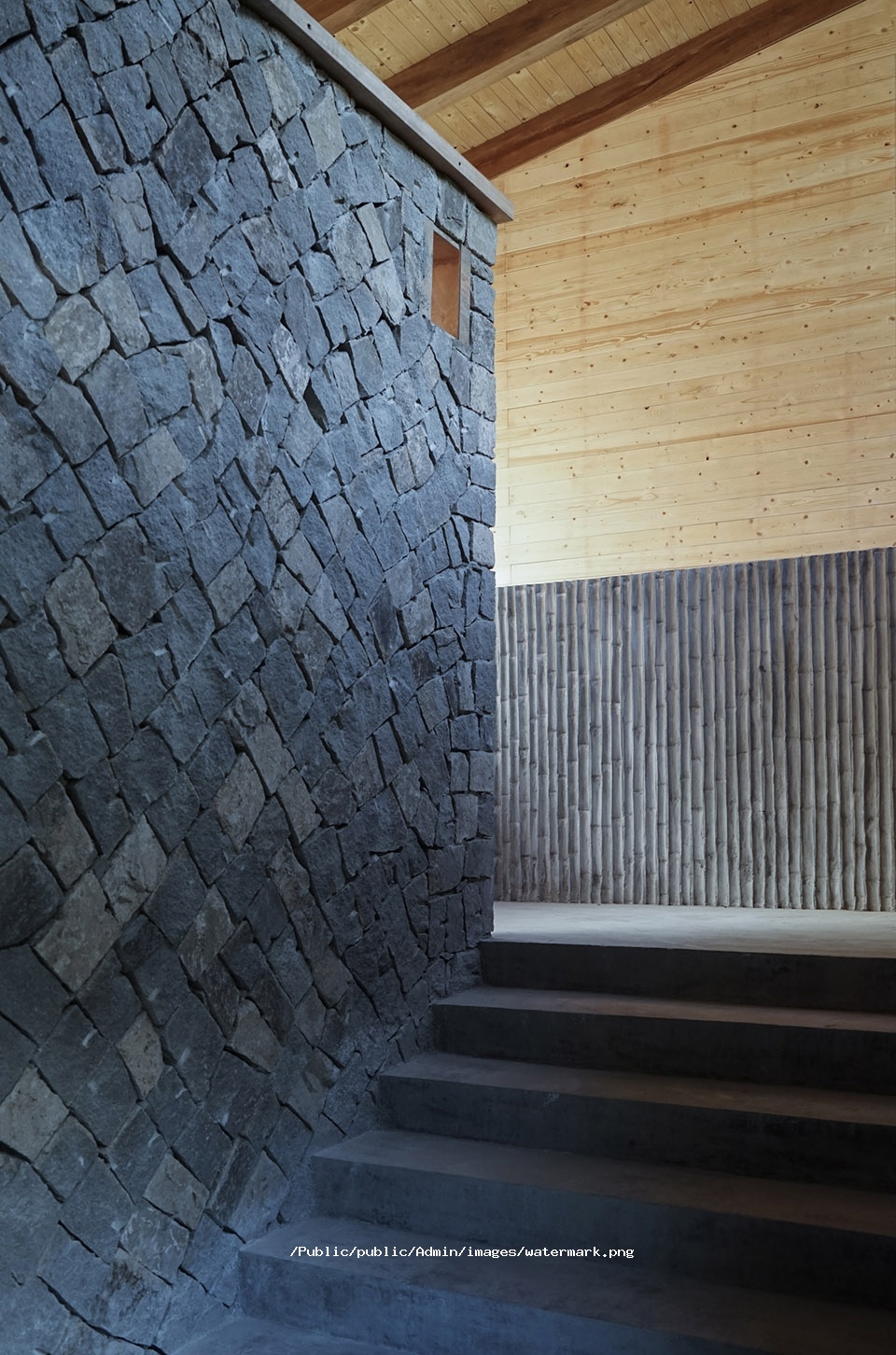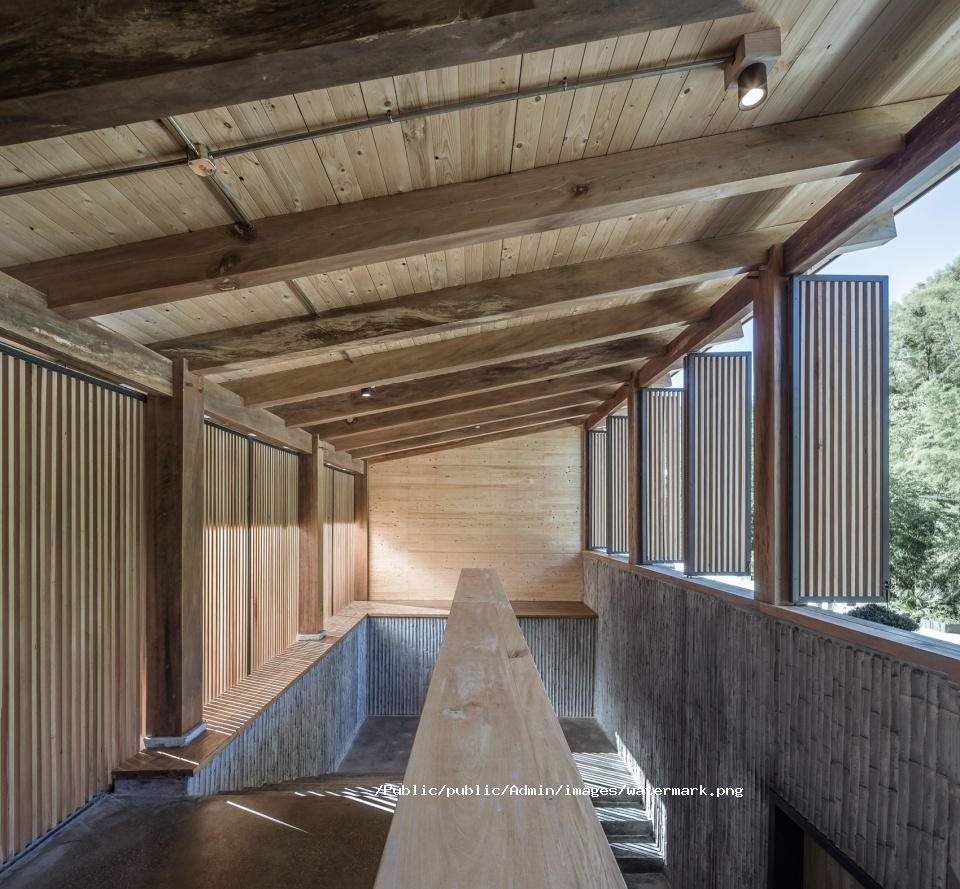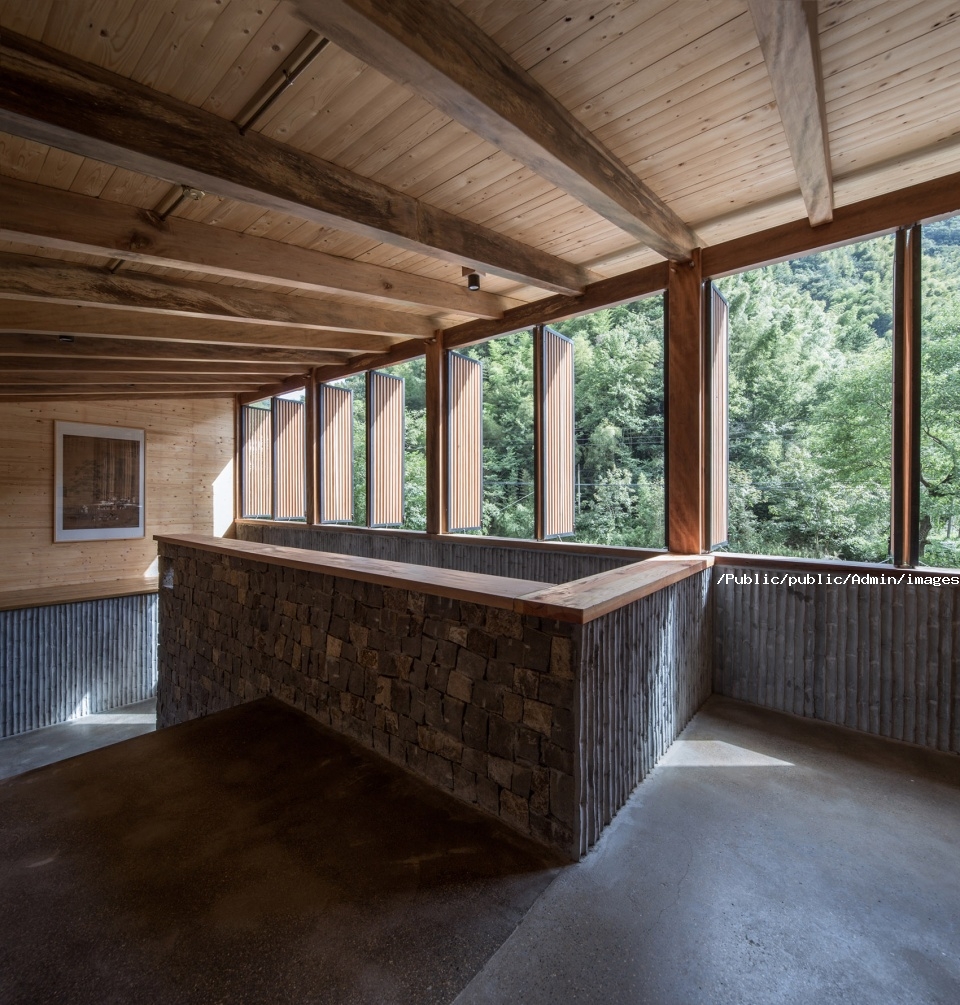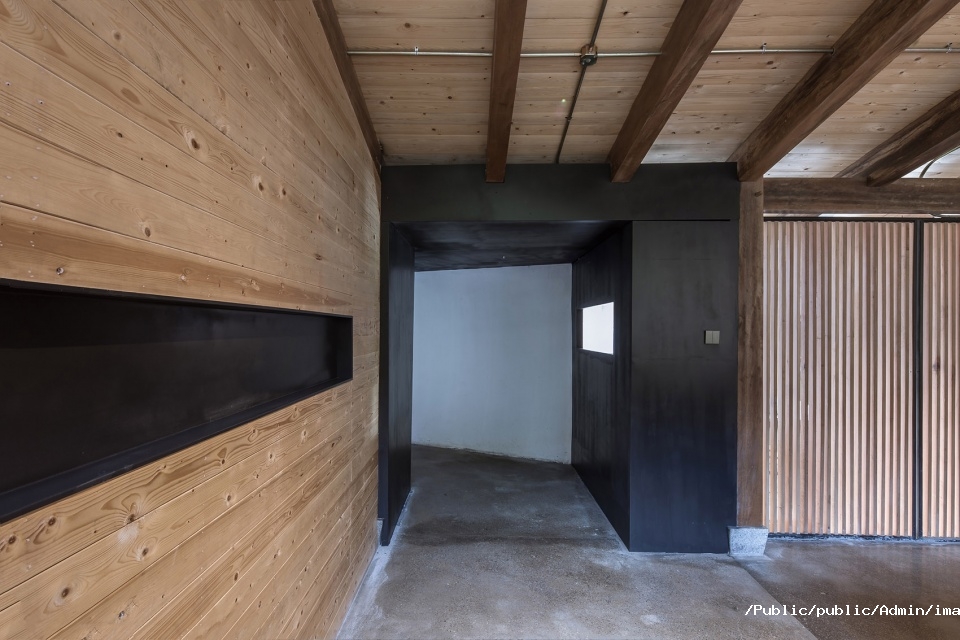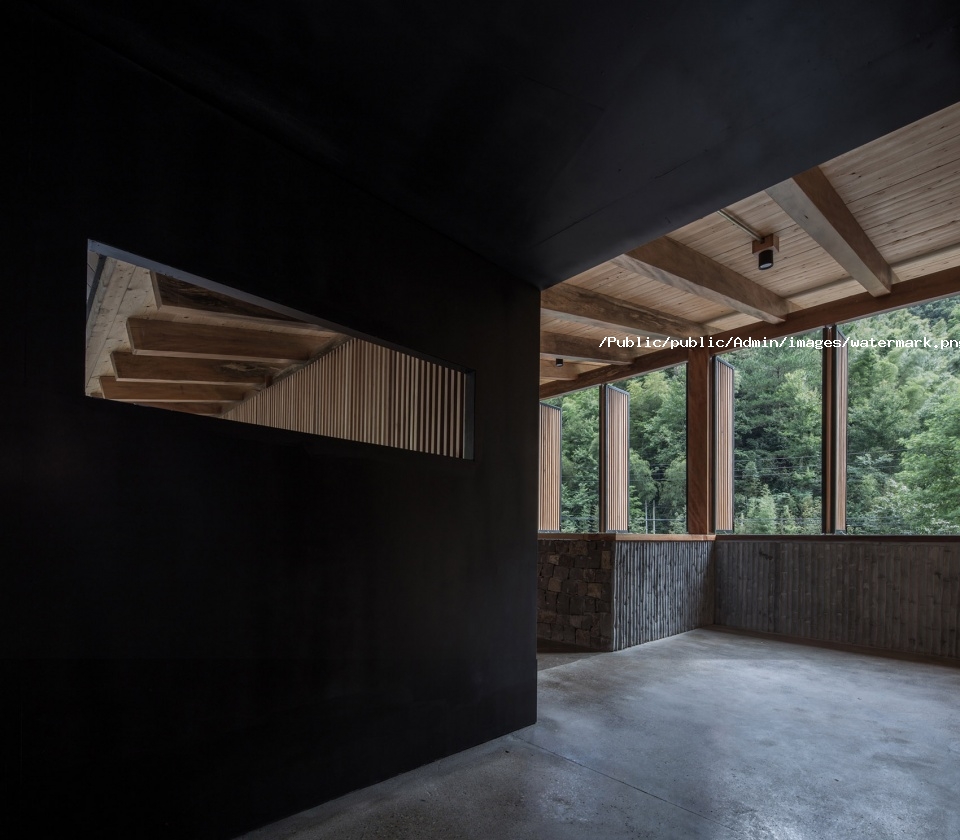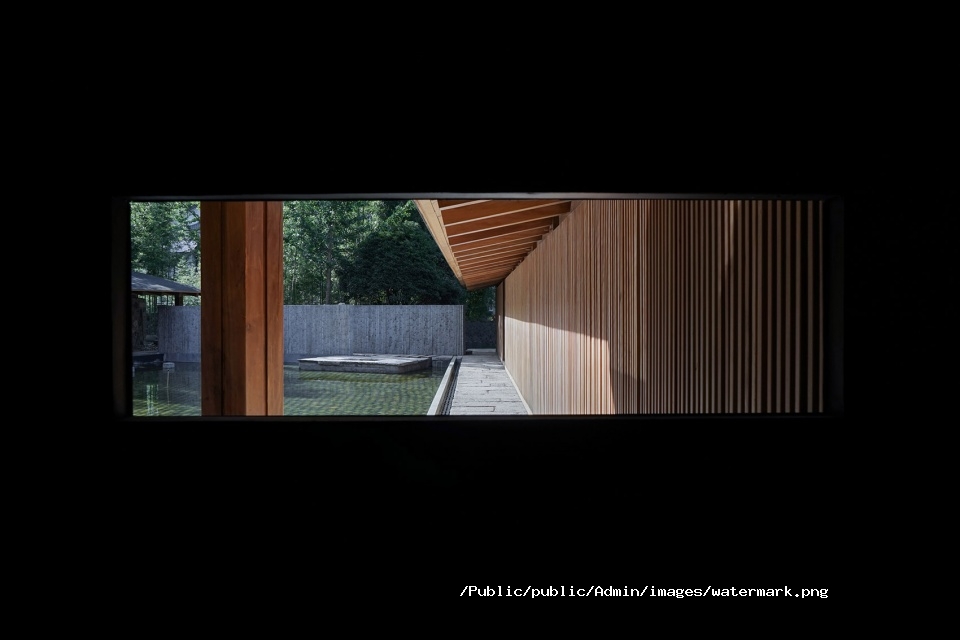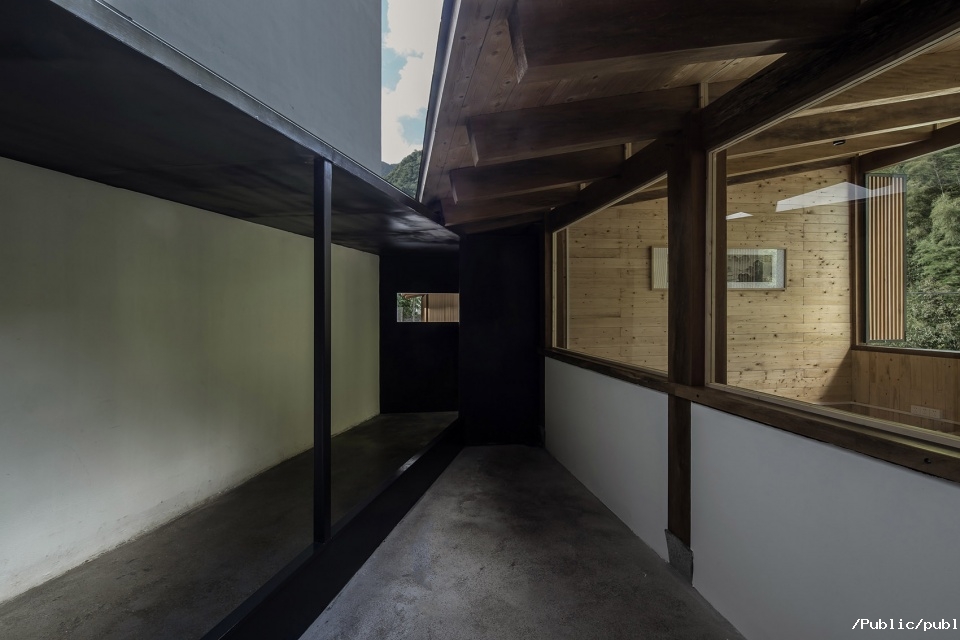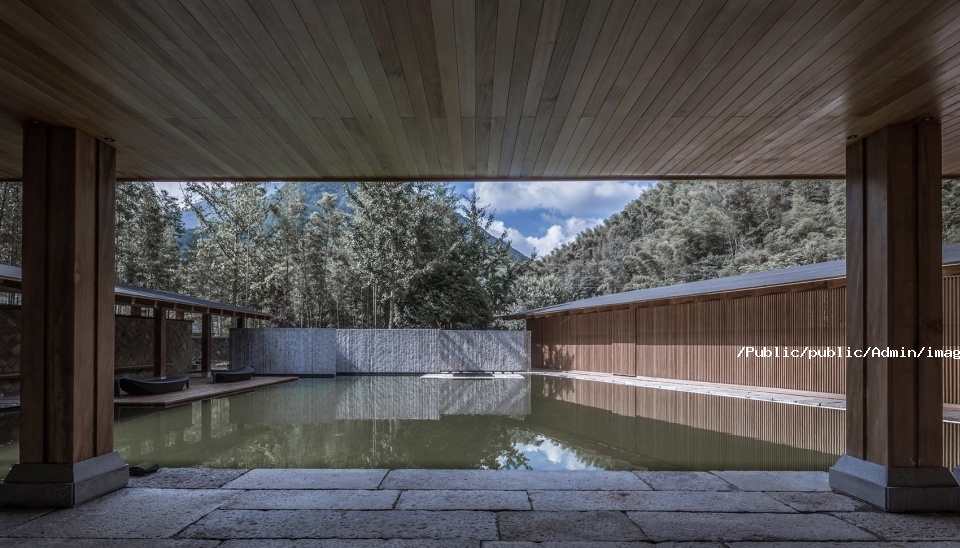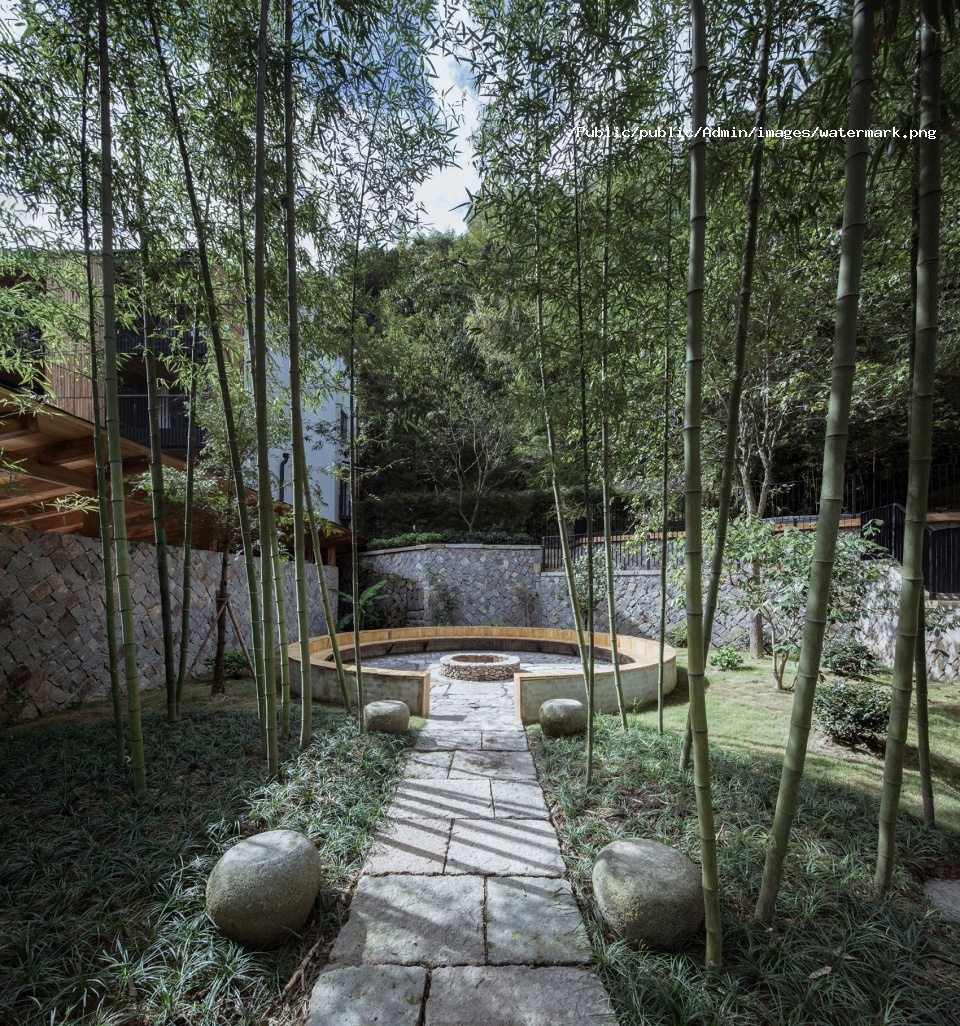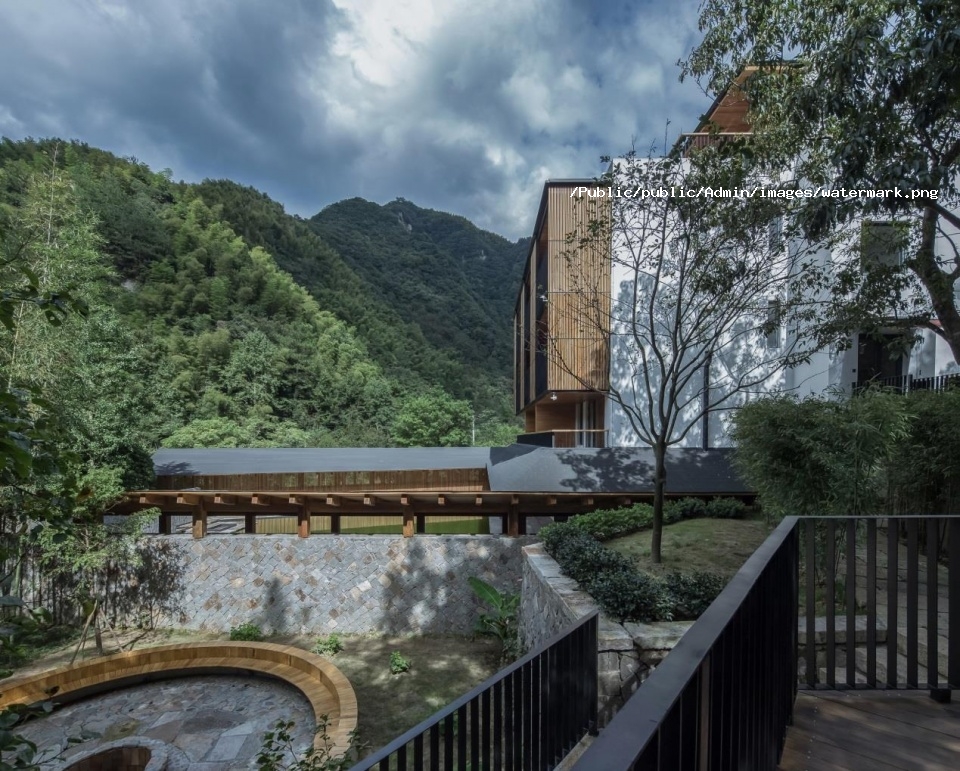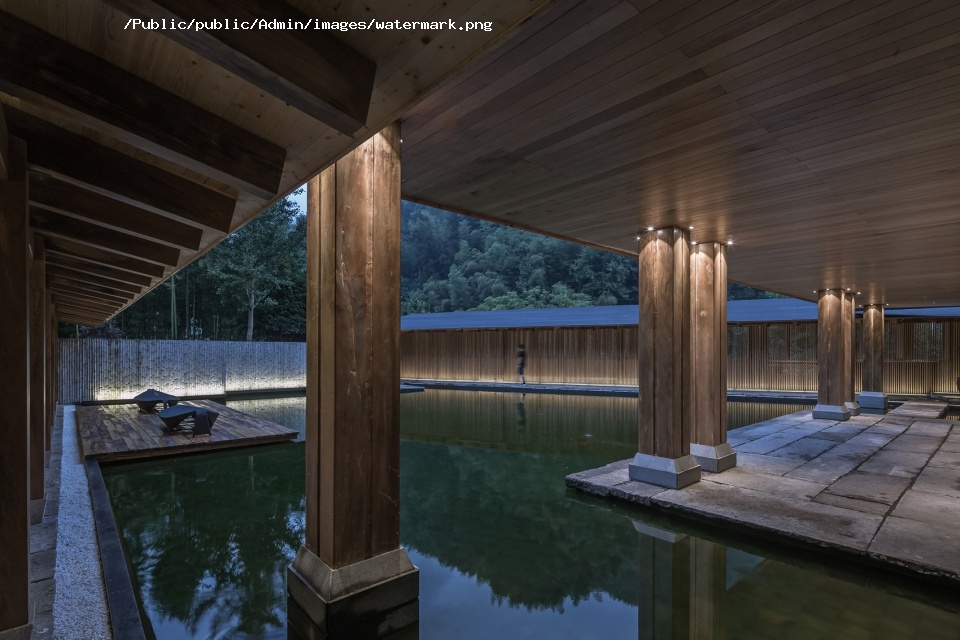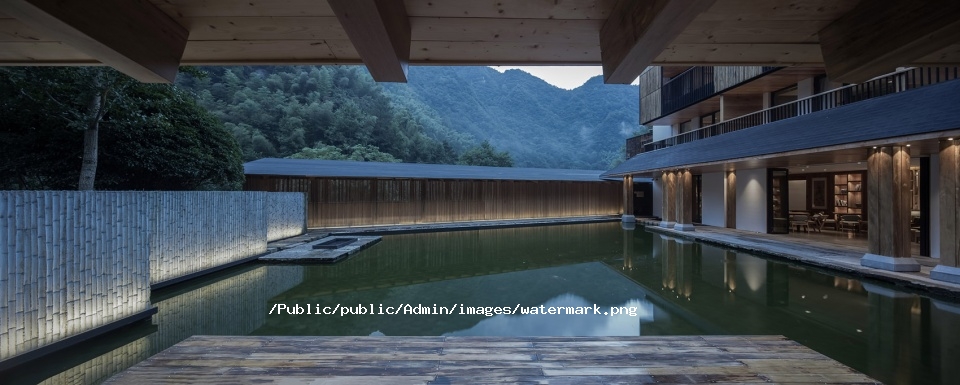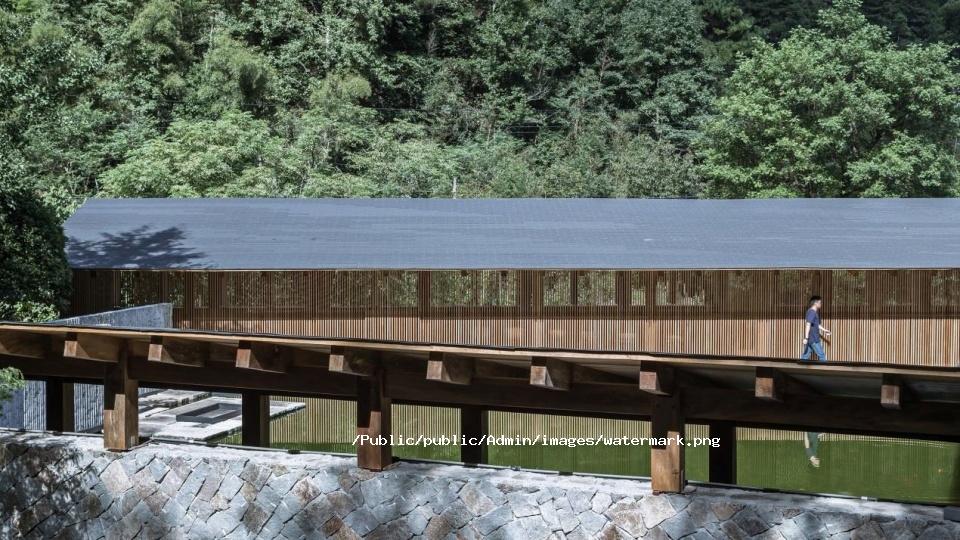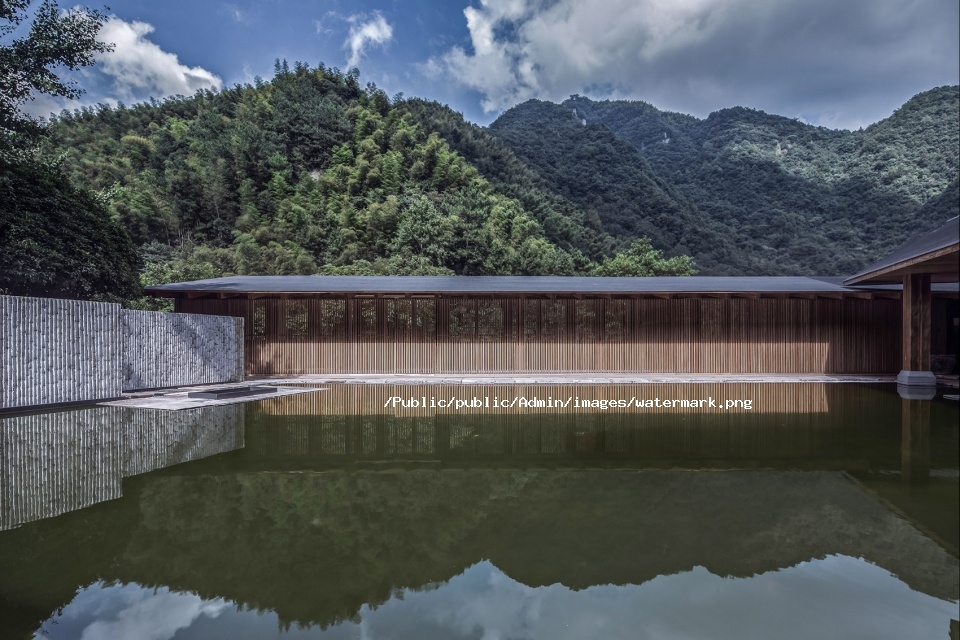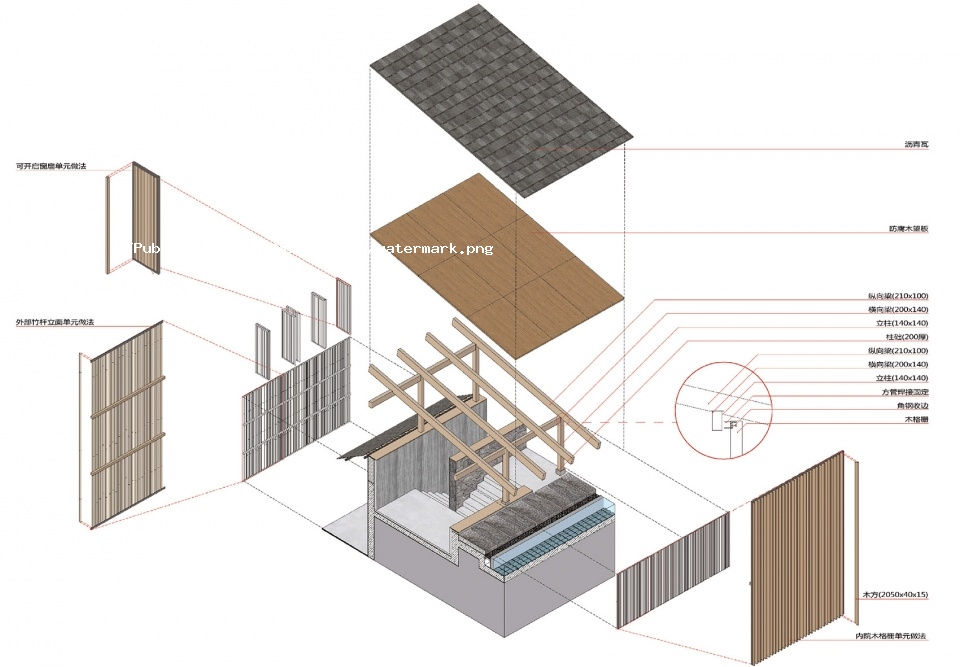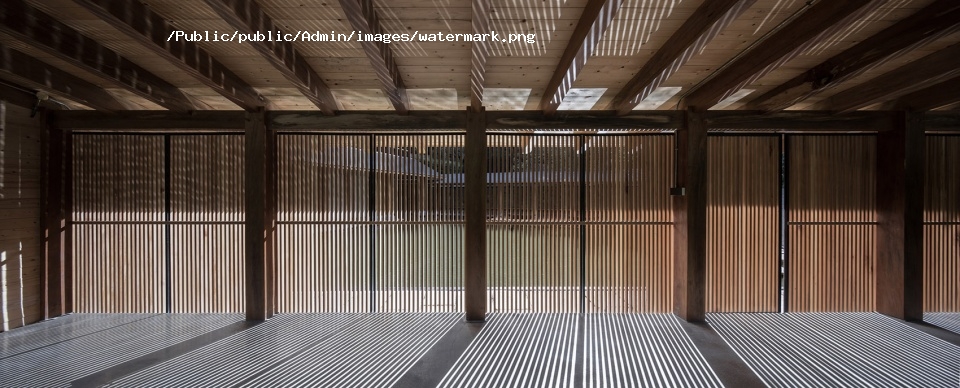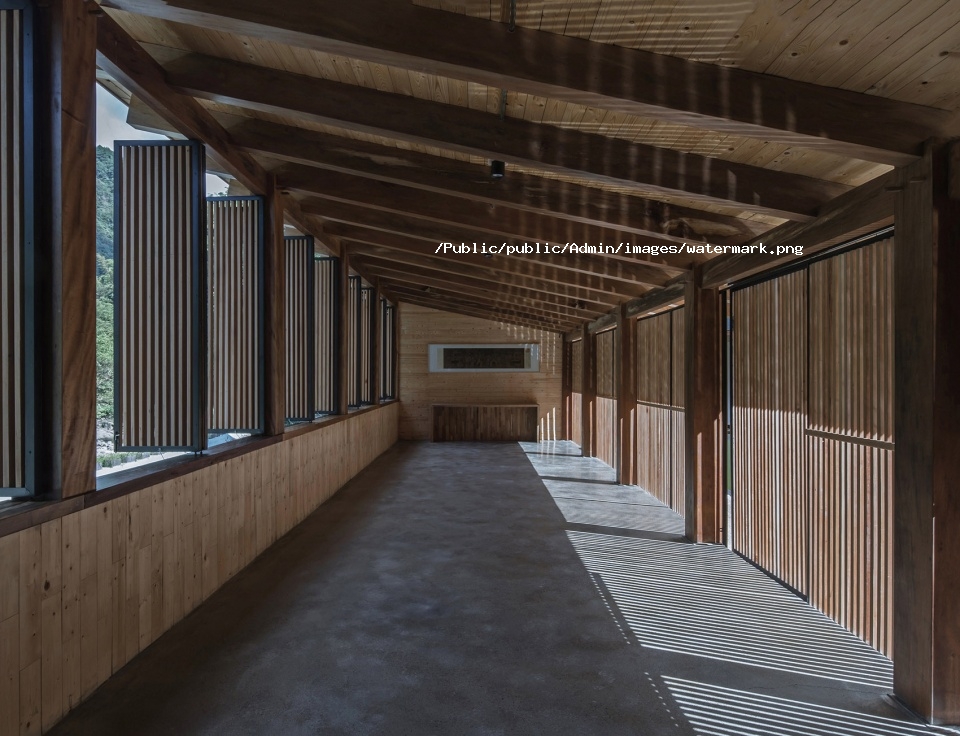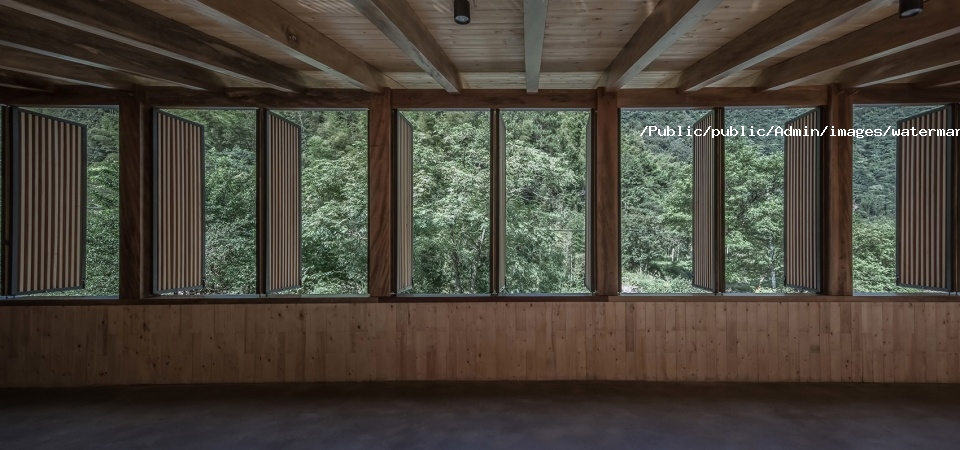临安鱼乐山房民宿
现代简约 m²
项目缘起
Project Background
鱼乐山房,是杭州临安太湖源的一对农民夫妇在自有土地上经营的老牌农家乐。经营十多年来积累了极好的口碑。但200元包吃住的客单价越来越难以维持经营,淡旺季巨大的接待量差距和较低的客源素质水平也使得夫妇俩疲于应付,所以二人决定对山房的物理空间进行改造,以期提高盈利能力,并为客人创造更好的度假居住体验,让山房完成从农家乐到“高端”民宿的转变。
Yule Mountain boutique hotel, an old-fashioned farmhouse operated by a peasant couple in Taihuyuan, Lin’an, Hangzhou, had accumulated excellent reputation during over a decade. However, they could barely stay afloat under the price of 200 Yuan per person which including board and lodgings in recent years. The huge variation of reception volume between the off-season and peak-season as well as the low-quality guests also challenged the couple. For these reasons, the owners decided to transform the physical space of the farmhouse, expecting to enhance profitability and improve living experience for the guests, making the Yule Mountain farmhouse to be a boutique hotel from the farmhouse.
▼从太湖源溪水方向看酒店外观,exterior view of the hotel from creek Taihuyuan ©Yi-Long Zhao
久舍营造工作室接受了业主的邀请,主持山房的建筑和室内空间改造设计工作。
Continuation Studio, after accepting the invitation of the proprietors, launched the renovation project with architecture and interior design.
▼外观局部,从大厅对岸露台回看主体建筑,partial exterior view, looking back at the main building from the terrace on the opposite side of the hall ©Yi-Long Zhao
▼外观局部,3-4层阳台构成的完整板片化体块,partial exterior view, the sheet volume formed by 3rd-4th floor balconies ©Yi-Long Zhao
场地原状
Original Site
不同于新建建筑设计,改造设计面对的现状问题通常更为复杂。山房所在白沙村位于天目群山环绕下的太湖源溪边,只通过一条省道与外界相连,颇如桃花源般与世隔绝。村庄周围景区繁多,旅游业发展很早,村内分布了众多形式各异的大小农家乐建筑。
Unlike constructing a brand-new building, transformation of status quo would be more complicated. Baisha village, where Yule Mountain boutique hotel located, is situated on creek Taihuyuan which surrounded by Tianmu Mountains. It can only be accessed through a provincial road, just like an idyllic hideaway. Due to the development of the tourism, scenic spots scattered here and there in the surrounding countryside, along with them, various farmhouse hotels are built to host guests.
▼场地建筑原状鸟瞰,可看到溪水、省道、邻居住宅和场地内外的高差关系,the aerial view of the site, the relationship of the rill, highway, neighbors and height difference can be seen ©continuation studio
建筑北侧的台地庭院约15米见方,与西侧山野有截水沟相隔,山上汇水经此由下穿的涵管排入溪水。庭院北侧是一片竹林,隔开邻居红砖搭建的住宅。庭院东侧边界比紧邻的省道高近3米,形成台地。上由约3米进深的传统双坡木构廊亭和一栋餐厅包间建筑作为台地的边界;3米左右宽的台阶嵌入台地,作为场地主入口与下部的省道联通。台地东南角另有一栋两层高的餐饮辅楼(从省道看为三层),由外部楼梯进入上层。这些沿台地边布置的建筑在省道方向都呈现出2-3层的立面高度,主体建筑山墙面更是尺度巨大。
The courtyard was located at the north side of the main building which is approximate 15 sqm. Separated from the mountains on the west side by an intercepting ditch. The water from the mountains was drained into the creek by the culvert underneath. There was a bamboo forest in the north side of the courtyard, separating the courtyard from the neighbors, a red-brick building. The east border of courtyard was nearly 3 meters higher than the provincial road, forming a terrace with a 3-meter depth traditional double-slope wooden pavilion and a restaurant as the boundary of the terrace. The 3-meter wide steps were embedded in the terrace, serving as the main entrance of the site and the connection to the provincial road as well. Another two-story dining building (three-story height when viewed from provincial road), which can be accessed by an external staircase, stood in the southeast of the terrace. The façade of these buildings which were arranged along the edge of the terrace showing the height of 2 or 3 stories when viewed from provincial road, and the gable of the main building was even larger.
▼基地分析,项目场地紧邻的山林与奔腾的溪水,site analysis, mountains and rill adjacent to the site ©continuation studio
溪水就在场地东侧自北向南流淌,比省道又低3米左右,作为太湖的主源头之一,此溪每当下雨就水声隆隆,在原建筑内也听得见。省道夹在场地与溪水景观之间,交通繁忙,有一定的噪音。
The creek, which is about 3 meters lower than the road flows, from north to south at the east side of the site. When it rains, the sound of the creek can be heard in the original building. The noise form the road was also audible because of the heavy traffic.
▼基地分析,场地中建筑、台地、省道、溪水的关系,site analysis, the relationship of buildings, terrace, provincial road and creek in the site ©continuation studio
山房原主体建筑位于场地南部,坐南朝北,背山靠林,是一个四层半高,五开间的庞然大物。和那个年代(2000年左右)全国盛行的景区旅游建筑一样,以仿青砖贴面,硬山坡屋顶和雕刻精致的花格门窗扇等符号化的做法,构成了所谓“中式”的乡村农家乐风格。
The original 4-storey, five-bay open main building was located on the south of the site, facing south and against the mountains. Like the tourism buildings that were prevalent throughout the country in the 2000s, this building was symbolized by the use of imitation blue brick veneers, flush gable roofs and exquisitely carved timber doors and windows, forming the ‘traditional Chinese’ farmhouse style.
▼改造前建筑正(北)立面,坐南朝北,背山靠林,四层半高,五开间,the original north elevation of the original 4-storey, five-bay open main building, facing south and against the mountains ©continuation studio
重见山水
Reemergence Of Landscape
综合这些信息,我们认为,稀缺的山水景观与地形高差是这块场地最具独特性的资源。但嘈杂的省道,模糊的场地边界,封闭的房间设置等,都让客人堕入繁杂的日常,而对山水“视而不见”。青山与绿水只是山房周围与省道、车辆混杂的背景而已,并没有成为值得凝视的风景。必须将“视而不见”的山水从混沌的环境背景中过滤出来,变成空间氛围体验的主题。只有这样,在山坳里的这一组大体量的建筑才有可能具备存在的合理性:它应能够与这片山水共舞,而不是像周边那些枉顾山的存在的农家乐建筑一样兀自高傲。——“重见山水”成为我们改造的目标。
山水,作为中国人肉身与精神的双重家园,历代都为空间营造者奉为模仿再现的对象。特别是众多处于城市地的江南园林,都在内部建立了一个超脱于外部世俗世界的山水空间。而我们的场地,虽处山林之地,但自身周界封闭,周边村舍屋宇建造粗糙简陋、面貌乏善可陈,省道嘈杂繁忙,对于场所空间氛围的营造都构成很大损害。因此,我们需要将山房营造成为一个独立于外部世界的小宇宙。它不仅需要穿梭虫洞般幽深的入口才可到达;而且进入后的一切,都将远离尘世,只与山水共同呼吸。
With all things considered, continuation studio believes that precious landscape and great terrain difference are the unique sources of this site. However, instead of enjoying the water and mountains nearby, guests still in the hustle and bustle of the city owing to the noisy provincial road, the unclear boundaries of the site and the sealed space setting of the guest rooms. The beautiful scenery became a useless background rather than a valuable landscape. The neglected landscape must be revealed from the noisy environment and become the theme of the spatial experience. Only in this way, the group of large dimension buildings can have the rationality of existence: It should be integrated into this landscape, unlike the incongruous farmer’s houses in the surroundings which show no respect to landscape. —— “Reunite with landscape” became the goal of this project.
Landscape, as spiritual and physical sustenance of Chinese people, is the everlasting spatial subject for space creators to borrow ideas from. Gardens located in the southern urban realm, always have sublime landscape inside, separating itself with the exterior carnal world. Looking back to our case here, though stand amid the mountains, the site has been impacted by the closed perimeter, the rough farmhouses and the tumult in the highway to achieve a proper spatial aura. Therefore, we need to build the boutique hotel into a “small universe “which is independent of external world. Guests need to walk through a deep entrance to get there, after which, social uproariousness would disappear and landscape would be the only thing you live with.
▼原场地边的山景,the landscape beside the original site ©continuation studio
界定的场地
Site Definition
对于这块场地来说,那么大的建筑体量以如此松散的状态分布,使得外部场地呈现一种碎片化的状态,并且与省道、邻居菜地和山脚野林混杂在一起,不利于形成独立有效的场所氛围。因此,改造的第一步便是对场地的重新界定。顺应地形的现有高差,我们将原有外部场地空间划分为三个部分:外部的省道,正对主体建筑的内院与坡地上的山野。最靠外的部分是省道、场地入口及停车区域。作为进入场地的前导空间,边界台地的高差宣告着外部世界的终止。台地之上正对主体建筑的部分设定为内院,作为山居氛围营造的最主要场地,内院与主体建筑构成隐含的轴线,在场地内形成“正观”的观景方向。内院和省道、山野之间以明确的界面隔开,动静分区。而山野部分则提供了各种活动体验的空间需要,坡地地形也易于对不同的活动区域在标高上自然划分。
The loose distribution in the site for such large building volumes made the external area to be in a fragmented situation. Also, the site was mixed with highway, vegetable plots and wild forests, which was not suitable to shape an independent and effective locale ambience, accordingly, the first step of this renovation was to redefine the site. Following the existing height of the terrain, we divide the original external space into three parts: the external provincial road, the inner courtyard and the mountains on the slope. The outermost part includes provincial road, the entrance and parking lot. The raised terrace, as the guiding space for entering the site, isolated site with external world. The inner courtyard which faces the main building is the significant place for creating the living atmosphere. The inner courtyard and main building constitute a hidden axis, forming a ‘straight viewing’ direction in the site. The inner courtyard, the provincial road and mountain fields are separated by clear interfaces. An experiencing space for various events and activities was arranged in the mountains part, and it is natural to put various active areas on different levels of the slope.
▼场地的重塑,将原有外部场地空间划分为省道、内院和山野三个部分,the reshape of the site, dividing the original external space into three parts including the provincial road, the inner courtyard and the mountain fields
场地经过重新界定,则内外有别,主次有序,动静相隔。一个内部世界的独立性与系统性才有可能被建立起来。
The redefinition of the site differentiates the inside and outside, the primary and secondary as well as the vigor and tranquility, thus, the independence and systematicness of an internal world is likely to be established.
▼改造后总平面图,the main plan (after renovation) ©continuation studio
深悄的动线
The Deep And Serene Circulation
原场地的入口动线非常直接,从省道直接冲上台地内院,从主体建筑景观面横穿了原本就不大的院落,大堂的主景观面被不断进出的客人穿破。从外部嘈杂省道进入室内的过程也缺少缓冲,很难迅速进入山居的平静状态。
The circulation of the original entrance was very straight. Guests would cross the provincial road directly to the inner courtyard, piercing the main landscape of the lobby. The process of entering the inner space from the external noisy highway is lack of buffering as well, making it is difficult to quickly involve into the peaceful atmosphere of the boutique hotel.
▼改造前后的入口动线对比,comparison of entrance circulation before and after renovation ©continuation studio
▼改造后入口动线与视线,the circulation and sightline of the entrance ©continuation studio
改造中,我们保留了原主入口的位置,将它藏于一道台地与道路之间的新增影壁墙之后。再将原本垂直于台地的台阶改造为平行嵌进台地边缘的折跑阶梯,置入重新整合的现代木构廊架之下。这个沿省道边展开的木廊架占据了原来传统木构廊亭与独栋餐厅包间的位置,将入口台阶、廊亭活动和入口左侧的新增办公室整合在一起,成为一个30米长的水平超尺度界面。连续的可开闭木格栅窗扇系统从立面上统一了廊架内的不同功能;由廊架内延伸到外部的均质方木椽条也暗示了这个界面的深度,并削弱了后部主体建筑的外部高度;而连续窗扇下的水平披檐也将入口立面的视觉高度有效降低,台地的高差从立面被暗示出来。
During the renovation, we keep the location of the original main entrance unchanged and hid it behind a screen wall between the terrace and the road. After that, we transform the steps that were originally perpendicular to the terrace to a staircase that ran parallel to the edge of the platform, and place it under the modern wooden frame. This wooden porch lines along the provincial road replaced the existed traditional wooden pavilion and the detached restaurant, integrating the entrance steps, the pavilion and the new office on the left side of the entrance,becoming a 30-meter vast scale horizontal surface. Continuous timber window system unifies the different functions in the corridor from the elevation; Rafters extend from wood corridor to external space also indicated the depth of this surface, lowered the visual height of the main building. The eaves under the continuous windows effectively reduce the visual height of the entrance façade, and the height difference of the terrace is implied from the elevation.
▼改造后的入口立面,入口被藏于一道台地与道路之间的新增影壁墙之后,the elevation of the entrance, the entrance is hidden behind a screen wall between the terrace and the road ©Yi-Long Zhao
由入口进入廊架,阶梯抬升的方向及上部屋顶的倾斜,进一步强化了地形的抬升与山景的高低。原本省道边的嘈杂氛围,经过影壁墙、木构廊架的基座,以及两段折跑阶梯中间的石块墙的多次阻隔后已得到很大程度的缓解。
Entering the porch, the direction of the step-up staircase and the inclination of the roof further strengthen the raise of the terrain and the height of the landscape. The strepitant atmosphere near the provincial road has been greatly improved after several obstacles including the shadow wall, the base of the wooden frame and the stone wall in the middle of the staircase.
▼入口阶梯,石墙后高处为内院溢入的天光,entrance steps, the high space behind the wall is the skylight overflowing from the inner courtyard ©Yi-Long Zhao
随着爬升,外部的山景天光由廊架外侧的连续窗洞溢入,省道车流被窗下墙遮挡,但流动的溪水声回响耳边,客人在爬升过程中便逐渐产生了溪山行旅的意境;同时,内院的景致,也在廊架内侧细密的竖向木格栅的过滤下,渗透出碎片化的光影。
Following the step, the skylight overflows through the continuous windows on the outside of the corridor. The provincial traffic is blocked by the lower wall under the window, only leaving the sound of the creek ringing in the ears, guests gradually formed excursion feelings during the climbing, filtering the scenery of inner courtyard through the grilles inside the corridor, projecting out scattered lights.
▼入口阶梯空间,阶梯右侧窗下墙及倾斜屋面下溢入的山色天光,左侧投下经木格栅过滤的内院光线,the entrance steps space, wall under the windows at the right side of staircase and the light overflowing from declining roof, and light from inner courtyard filtered by wooden grill, casting a shadow on the left of the space ©Yi-Long Zhao
▼入口阶梯空间,入口折跑台阶溢入的山景,the entrance steps space, overflowing landscape from staircase of entrance ©Yi-Long Zhao
设计将四层楼主体建筑的主入口从北侧正立面转移到建筑东侧山墙——由木廊架、二层独立辅楼和主体建筑围合的三角形区域内。从阶梯上来一直到山墙边,动线出现了非正交的转折。这一动作,首先将陡坎和主体建筑山墙之间的偏角以动线的连续边界整合;其次,原本台地上细碎的外部空间也被动线切分为入口三角院和内庭水院,两个院子都拥有了迥异的气氛和尺度;再者,在三角院与内院重叠处的一条短边界面上,我们设置了可以从一角窥视内部水院的横向窗洞,定格了内部水院可望而暂不可达的静谧画面。
The design strategy is to transfer the main entrance of the four-story main building from the north façade to the east gable, a triangular area circled by the wooden corridor, the two-story annex and main building. From the staircase to the gable, the circulation has a non-orthogonal turning point, as a result, firstly the deflection between the scarp and the gable is integrated with the sequential boundary of the circulation; Secondly, the external space on the terrace is also divided into the triangle courtyard and inner courtyard with water, which possess distinct ambience and scale respectively; Furthermore, we set up horizontal windows for peeping the inner courtyard from corner on the short boundary where the triangle courtyard and the inner courtyard overlap. Though the tranquility and beauty is unreachable provisionally, it is frozen by those horizontal window frames, alluring guests to approach the yard.
▼新入口处的三角院空间,从阶梯转向主体建筑山墙的非正交转折,the triangle courtyard at the new entrance space, a non-orthogonal turning point from staircase to the main building ©Yi-Long Zhao
▼入口阶梯到顶后回看,溪对岸的山景从打开的窗扇中铺面而来,looking back from the end of staircase, viewing the landscape across the creek from the opening window ©Yi-Long Zhao
▼从廊道转折处一窥内院,peeping from the turning point of corridor ©Jiu-Jiang Fan
经过三角院落后,贴主体建筑山墙面,进入建筑内的走道,原本廊院的阴翳变得更为昏,只有走道内部地面反射的外部天光。向右转进接待大堂,站在大堂正中向院落看去,视线豁然开朗:一片平静的水面从大堂外檐下铺陈开去,远山在水岸对面三道片墙与竹林后露出云雾缭绕的顶部,左侧的长亭,右侧水榭(从省道方向看为水平木构廊架)的细密均质的木格栅界面,都由水面倒映后使山水景观成为视野中的饱满主题。压低的大堂外檐、对称的立柱、青石设的平台,都让宁静致远的山居氛围得以在仪式感的观景空间内稳定呈现。
After passing the triangle courtyard, along the gable of the main building, entering the corridor inside the building, guests can see a gloomier space only with reflected sunlight on the floor. Turning right to the reception, standing in the center of the lobby and looking at the courtyard, visitors would face an open and clear sight, totally distinct from the shadowy corridor space: a placid water spreads out under the eaves of the lobby, in which the cloudy top of mountains behind three walls and bamboo forests, the long pavilion on the left side, and the homogeneous timber grill of the waterside pavilion (horizontal wooden frame when seen from the provincial road) are reflected, and a sublime landscape picture is created in visitors’ view. The lowered outer-eaves, the symmetrical columns and the bluestone platform present a peaceful living atmosphere with a sense of ritual.
▼经过三角院落后,贴主体建筑山墙面,进入建筑内的走道(左侧廊道后白墙为主体建筑山墙),after passing the triangle courtyard, along the gable of the main building, entering the corridor inside the building (white wall behind the left corridor is the gable of main building) ©Yi-Long Zhao
至此,整条入口动线在经过遮隐、转折、抬升、停顿、窥视、远离、钻入、放开的一系列操作后,达到最终的高潮。这一全新入口动线的设计,使山景、院景和建筑自身构成的景观,以不同的面相呈现在体验者的面前。谨慎控制的光线和渐进叙事的场景强化着溪边地形的抬升与方向的转换,极大增加了山地空间的信息稠度。从外部省道边的喧嚣,到折跑台阶的廊架,从省道一侧的高处山景,到被窥探一角但暂难进入的静谧水院,从阴翳的屋内廊道,到大厅正对的静谧山景,这种声音、重量、高度、光线的明显变化,密集地调动着客人的好奇心和期待感;多次转折也拉长了从入口到进入主体建筑的时空心理距离,近在咫尺的内院与省道仿佛山腰与山脚般遥远,一个独立于外部的山中小世界得以初步建立。
At this point, the whole circulation in the entrance climaxes after hiding, turning, rising, pausing, peering, escaping, piercing and releasing. With the redesign of circulation, the mountains, courtyards and the main building present themselves to the guests with various landscape views. The exquisite light and progressive narrative scenes emphasize the rise of the terrain, greatly enriching the mountain space with affluent information. From the uproariousness of the provincial highway to the corridor frames of stairs; from the mountain scenes in the side of the provincial highway to the peaceful inner courtyard; from the shading corridor to the mountain scenes, these noticeable alterations in sound, weight, height, and light tantalize the guests, arousing their curiosity and expectation. The multiple turnings also lengthened the psychological distance from the entrance to the main building. Then, an independent small world was initially established in the mountains.
▼从酒店大厅看北侧主景观面,main view at the north side of lobby ©Yi-Long Zhao
▼动院高处的三层台地与远山,three-story terrace on the inner courtyard with landscape behind ©Yi-Long Zhao
▼静院,水面延伸到主体建筑檐廊之下,右侧为茶亭廊道,the inner courtyard, the water spreading out to the porch of main building, corridor of tea house standing at the right side ©Yi-Long Zhao
茶亭朝内一侧界面为连续的细木格栅固定单元,从内院看,细木格栅遮挡了茶亭的结构柱,纯净的细木矩阵与平整的沥青瓦屋面具有类似细腻质感的二维化界面,共同衬托着上部与背后渗透进内院的山林景观。从茶亭中看,这层界面在木柱后方,如织物般将内院的水色天光过滤,在内部地面与屋面上投射出细密的光影,水院景色呈现为一种边界模糊的梦境。
Inner side interface of tea pavilion is comprised of fine timber grill modules, which hide the column of pavilion from inside view. Pure timber modules and smooth asphalt roof possess a similar two-dimensional interface with fine texture, setting off the beauty of the permeated landscape. When viewing from pavilion, the interface of timber grill filters the water and sky of inner courtyard like fabric, casting subtle shadows on ground as well as roof, presenting a dreamland with blurry periphery.
▼水榭朝内一侧的细密木格栅界面,fine timber grill at the inner side of pavilion ©Yi-Long Zhao

办公装修要花多少钱?
目前已有 61 人获取装修报价
预估报价
-
454657
元









